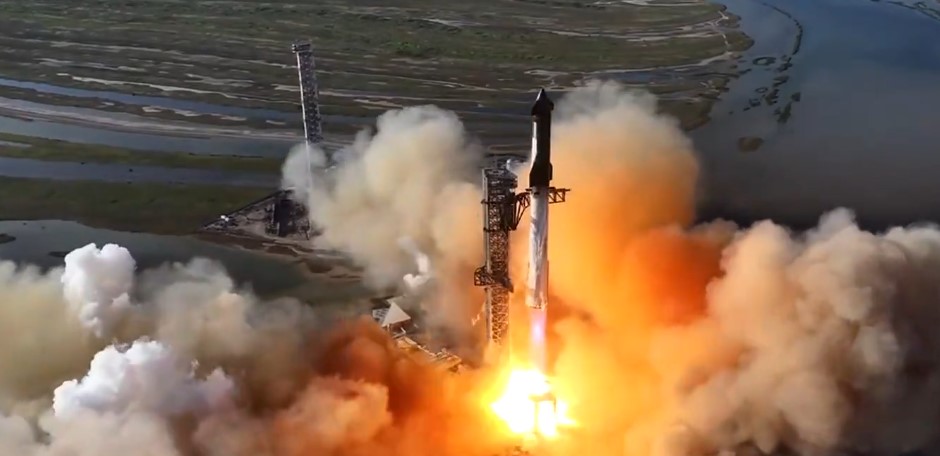
(Photo : https://www.spacex.com/)
Mars-Bound Starship Takes Flight
- SpaceX's Starship rocket, designed for moon and Mars missions, was launched from Texas, witnessed by President-elect Donald Trump.
- The mission faced a setback when the Super Heavy booster deviated from its planned trajectory and splashed down in the Gulf of Mexico.
- Despite the setback, the mission marked significant progress in SpaceX's spaceflight program, with Trump showing interest in the company's ambitions.
- The FAA's quick license approval for the launch signals a deepening alliance between Trump and SpaceX, potentially revolutionizing space travel and exploration.
In a significant event that marked a new chapter in the annals of space exploration, SpaceX, the aerospace manufacturer and space transportation company founded by Elon Musk, launched its colossal Starship rocket into space from Texas. The launch was witnessed by U.S. President-elect Donald Trump, who was present at the company's rocket facilities.
The Starship rocket, standing at an impressive 400 feet tall, is designed with the ambitious goal of landing astronauts on the moon and ferrying crews to Mars. The launch took place at 4 p.m. CT from SpaceX's expansive roc
ket development site in Boca Chica, Texas. The rocket's first stage booster, known as Super Heavy, detached from its second stage, Starship, at an altitude of approximately 40 miles, propelling the craft into space.
However, the mission did not go entirely as planned. The Super Heavy booster was expected to return to land, caught by large mechanical arms attached to the launch tower. Instead, it splashed down in the Gulf of Mexico, indicating a deviation from the planned trajectory.
Super Heavy's Unexpected Splashdown
A live stream hosted by space blogger Everyday Astronaut showed the Super Heavy booster exploding into a massive fireball on the Gulf horizon after splashing down. Despite the setback, the mission marked significant progress in SpaceX's spaceflight program. The Starship demonstrated its novel catch-landing method for the first time last month, achieving a key milestone in its reusable design. Tuesday's catch-landing was supposed to be faster/harder, Musk had written on social media before the launch.
The presence of President-elect Donald Trump at the launch signals a deepening alliance with Musk, who stands to benefit from Trump's election victory. Musk, the world's wealthiest person, was a prominent supporter of Trump's presidential election campaign, appearing with him at rallies and backing him with at least $119 million in political support.
Trump's Interest in SpaceX's Ambitions
Trump's interest in SpaceX's space ambitions was evident when he fixated on the booster's novel catch-landing technique at a rally following the Oct. 14 Starship test. Did you see the way that sucker landed today?, he said, expressing his fascination with the technology.
The rest of the mission appeared successful. In space, Starship traveled around Earth for a daytime splashdown in the Indian Ocean roughly an hour later. It reignited one of its onboard engines in space for the first time, an early test of its maneuverability in space that SpaceX had tried but failed to do in past flights.
NASA chief Bill Nelson, who is expected to leave his role once Trump takes office in January, congratulated SpaceX in a post on X and said Starship's in-space engine reignition marked major progress towards orbital flight.
FAA's Quickest Regulatory Turnaround for SpaceX
The U.S. Federal Aviation Administration's regulation of commercial rocket launches has been a source of frustration for Musk, who has complained that the agency impedes his company's progress in getting to Mars. However, the FAA's license approval of Tuesday's Starship launch a little over a month after the rocket's previous flight was its quickest regulatory turnaround yet for SpaceX.
Musk listed four core objectives for the test flight: restarting Starship's space-tailored engine during flight, making a more visible ocean landing during the daytime, putting Starship through more intense heat during reentry, and making the booster landing faster. There are thousands of small design changes also being tested, Musk said.
SpaceX is eyeing swift advances in Starship development during a second Trump administration. The administration's space agenda is expected to give NASA's Artemis program, which is due to return astronauts to the lunar surface, a greater focus on the more ambitious goal of landing people on Mars, Musk's premier space aspiration.
We just passed 400 launches on Falcon, and I would not be surprised if we fly 400 Starship launches in the next four years, SpaceX President and COO Gwynne Shotwell said at the Baron Investment Conference in New York last week, referring to the company's workhorse rocket.
This event is reminiscent of the historical Apollo missions, where the world watched with bated breath as astronauts were launched into space with the goal of landing on the moon. Just as then-President John F. Kennedy had a close relationship with NASA, Trump's alliance with Musk and SpaceX signals a new era of collaboration between the government and private space companies. This partnership could potentially revolutionize space travel and exploration, bringing us closer to the goal of colonizing other planets.
* This is a contributed article and this content does not necessarily represent the views of btin.co.in









